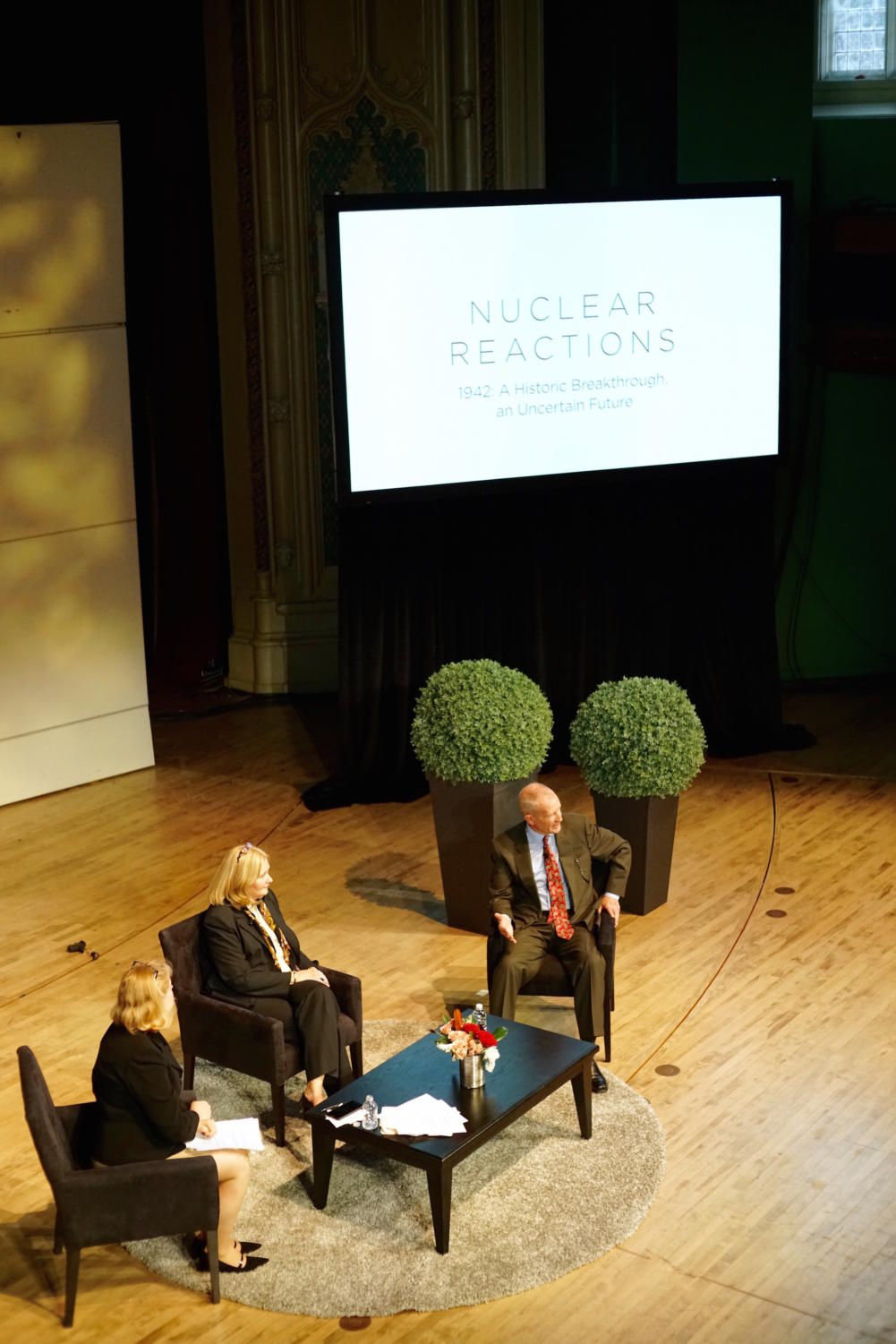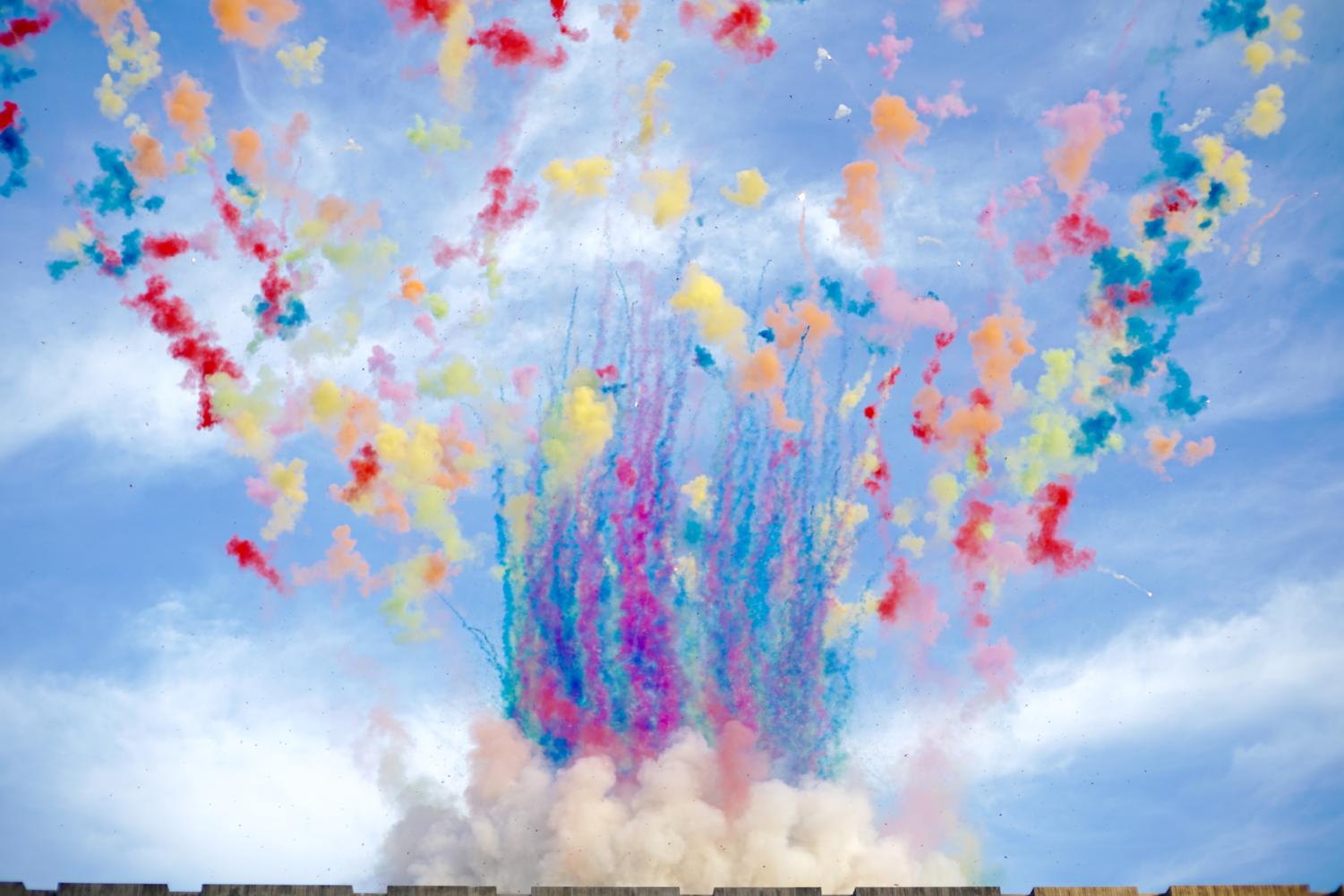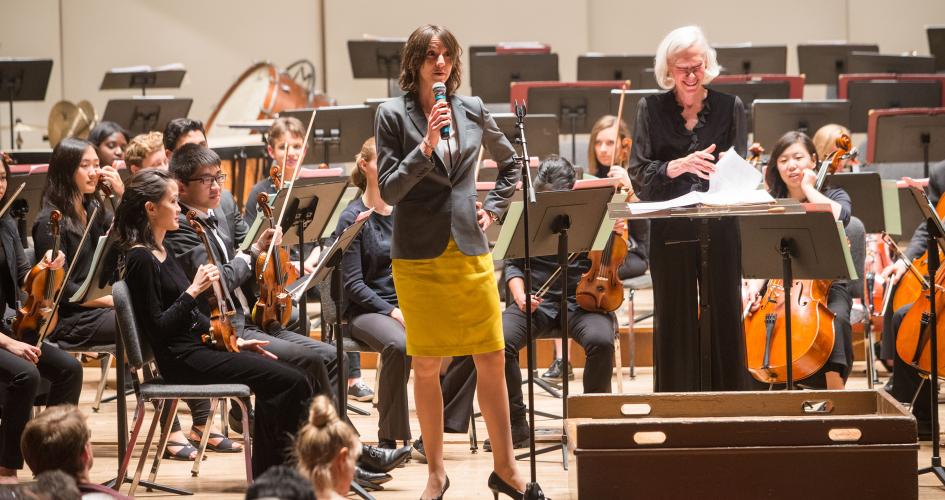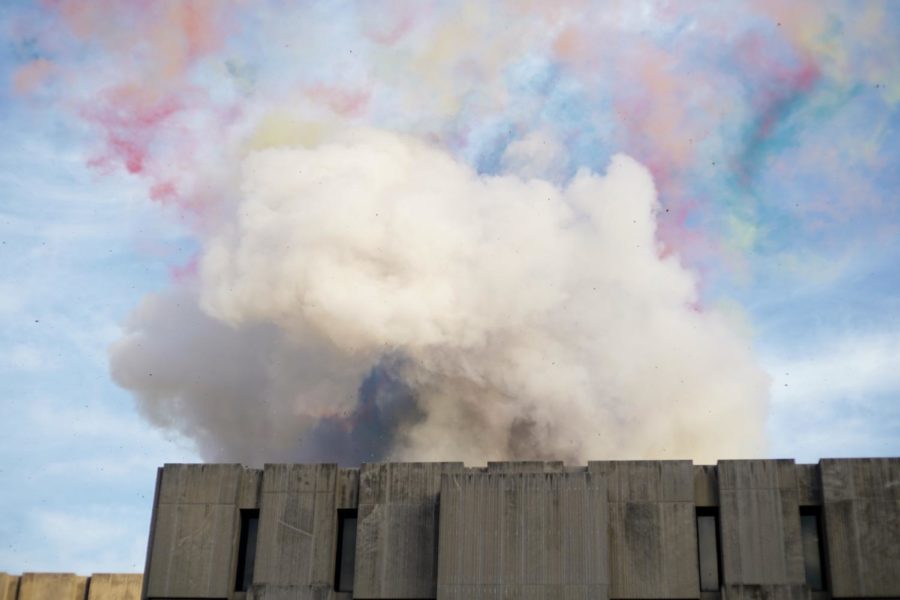Day One

The first day of Reactions: New Perspectives on Our Nuclear Legacy began with a video and speech narrating the journey Enrico Fermi and his team took in 1942, followed by three panels tackling the significance of the momentous discovery from economic, political, and medical standpoints. All three panels were moderated by Gretchen Helfrich, a civil rights attorney and the former host of Odyssey on WBEZ. Including the world premiere of Augusta Read Thomas’s original composition, “Plea for Peace,” and concluding with a keynote address by former Secretary of Energy Ernest Moniz, the first day largely revolved around a policy-based discourse concerning the progress of nuclear technology 75 years after the first self-sustaining nuclear reaction.
During the first panel, a conversation sparked between Chris Crane, president and CEO of Exelon, a leading American energy company, and Michael Greenstone, director of the Energy Policy Institute at the University of Chicago. Purportedly the source of 11 percent of the world’s energy, nuclear energy was viewed through the lens of a “climate-constrained world” and discussed in terms of the policies surrounding its use and its economic feasibility. The second panel featured a more militaristic examination of nuclear technology: Admiral Dennis Blair and Madelyn Creedon, former principal deputy administrator for the National Nuclear Security Administration, discussed the possibility of nuclear warfare in a post-Cold War era. Blair, Chairman of the Sasakawa Peace Foundation, expressed a relative sense of assurance, asserting that the primary function of nuclear weaponry today is the paralysis of the military landscape, rather than destruction. According to Blair, “stateless and messianic” terrorist groups are more likely to deploy such weapons than full-fledged nations (like North Korea), which have too much to lose.
Filing back into Mandel Hall from a brief intermission, attendees indulged in a live performance of “Plea for Peace,” a masterful vocalise for soprano and string quartet that the University commissioned from Grammy-winning professor of Composition, Augusta Read Thomas. Described by the New Yorker as a “true virtuoso composer,” Thomas explained that she initially struggle to represent “what it [CP-1] has meant for mankind, past, present and future, in a musical composition,” but ultimately succeeded in showcasing this complexity musically. First-year Aliya Khan, after attending the live premiere, described the piece as having “airy moments of hopefulness that are countered by an overarching tone of melancholy,” which seems as pleading as the title implies. In the program note distributed for the performance, assistant professor of music Jennifer Iverson writes: “The soloist’s elegant, wordless vocalise weaves in and out of the string quartet’s sustained harmonies in graceful counterpoint, drawing use closer to our common humanity.”
The final theme area tackled that evening was that of nuclear medicine and molecular modelling, a nascent field shrouded at once by astounding promise and debilitating misconception. Sanjiv Sam Gambhir, professor and chair of the Stanford University Department of Radiology, drew upon his experience within the technical field and with misinformed patients to dispel various myths about nuclear medicine. His interlocutor was Martin G. Pomper, Henry N. Wagner, Jr. Professor of Radiology at Johns Hopkins Medical School. Pomper shared exciting insights into the most recent innovations in molecular imaging, such as the manipulation of acoustic ethers to virtually “talk to” molecular tracers injected into patients.
Finally, the stage welcomed Ernest Moniz, co-chair and CEO of the Nuclear Threat Initiative. Moniz recounted his corporation’s work with mitigating the threat of nuclear catastrophe while maximizing the benefits of nuclear technologies. Given the apt illustration of this task’s complexity by the previous panels, Moniz’s address seemed a fitting end to the first day of Reactions.
Day 2

The second day started with students performing the dance piece “Meditation on CP-1” in the lobby of the William Eckhardt Research Center, which contained a tent-like structure emulating the nuclear pile built 75 years ago under Stagg Field. The piece was the result of a union between the arts and sciences: the brainchild of dance artist Emily Coates and physicist Young-Kee Kim. From swarming motions to hurried jogging in and out of the structure, wild convulsions to elegant displays of balance, the dancers’ motions and composer Sam Pluta’s accompanying abstract, electronic composition reified the invisible, chaotic nuclear choreography that constitutes our physical reality.
Back in the chilly outdoors, people gathered around Henry Moore’s sculpture where Bill Brown, Karla Scherer Distinguished Service Professor and senior advisor to the Provost for Arts, welcomed visitors to the commemoration event and introduced Chinese artist Cai Guo-Qiang. Accompanied by a translator, the pyrotechnician recounted tales of his artistic development and travels. He described how a dream he had for the 1994 opening of the Asian Games in Hiroshima never came into fruition and how a year later, after moving to the States, he was given access to the Nevada Nuclear Test Site. While there, he used gunpowder to conjure tiny white mushroom clouds: what he believes to be the most iconic image of our time. Following his 2008 return to Hiroshima, he was granted the Hiroshima Art Prize and dedicated a full day’s worth of fireworks to honor the lives lost to the nuclear horrors of the past, filling the sky’s blue with black, smoky blossoms that eventually coalesced into the gargantuan, fatal fungus that has scarred history forever. This day’s performance bore no less gravity.
The performance was initiated by 75 bell tolls from Rockefeller Chapel, counting the years that have passed since Fermi’s groundbreaking success. In unison, the audiences at the Rockefeller and behind Regenstein Library counted down the final five resonant tolls, after which a flamboyant barrage of 75 fireworks burst from atop the library, stretching 75 meters into the sky and forming a technicolored mushroom cloud. The wind, unfortunately, was not favourable that day. The spectacle disappeared swiftly, like a bitter powder in excess solvent. However, the brevity of the scene did not detract from its drama: Colossal and colorful, the smokestacks towered over the sea of faces below, engendering motley responses. Brown, for one, described the pyrotechnic installation as “ethereal, numinous, ephemeral…but monumental.” However, while Guo-Qiang expressed his intention to reclaim the destructive capacities of gunpowder and the devastating symbolism of the mushroom cloud in an expression of beauty and hope, not all agreed with the tone of his artwork. At the moment of the blast, several undergraduates threw themselves on the steps by “Nuclear Energy,” protesting the performance’s semblance of celebration and calling to attention the mortalities of nuclear power.


Meanwhile, speakers installed on-site gave awed viewers behind the Reg the chance to listen to “The Curve is Exponential,” a sonic telling of the CP-1 tale composed by Ph.D. student Ted Moore. A work for carillon and electronics, the piece was played by University Carillonneur Joey Brink. Indeed, much like Thomas’s premiere the previous day and the movement piece earlier that evening, Moore’s soundscapes acknowledge the terrible ambiguity Fermi and his team faced in 1942.
Afterward, Christine Mehring, current chair of the Department of Art History at the University, introduced the five speakers scheduled to give lectures in the McCormick Tribune Lounge. Introduced as “one of the greatest art-historical minds of our generation,” UC Berkeley professor emerita Anne Wagner was the first to speak, sharing with attendees her research concerning sculptor Henry Moore and his campus-famous “Nuclear Energy,” originally known as “Atom Piece.” Wagner detailed a history of the sculpture’s conception, tracing through Moore’s diaries and various archival photographs to its tentative translation from theory to plaster and its consummate immortalization in bronze. She contextualized Moore’s narrative, fascinating the audience with formal comparisons to such works as F.H.K. Henrion’s “Stop Nuclear Suicide” (1963), Hans Holbein the Younger’s “The Old Woman” (1526), and even Cindy Sherman’s “Untitled #160” (1986). Wagner’s main concern was the contradictions in play within the sculpture: between the fixed, protective roughness of the “legs,” so to speak, and the suspended, destructive smoothness of the “dome” on top.
Next came Luke Ogrydziak and Zoë Prillinger, who led the conversation away from art-historical analysis toward material design. Ogrydziak Prillinger Architects, a winner of the 2013 Emerging Voices Award, is the firm responsible for the design and installation of “Nuclear Thresholds” around the Moore sculpture. Their lecture was an elegant showcase of their design and production process: the mishaps, successes, and overall growth of their idea. “Nuclear Thresholds” is composed of 241 75-foot-long rubber cords arranged on one side in the form of a functional bench and on the other as a miasma of serpentine swirls—a transition from stability to a lack thereof. After reading their Architects’ Statement, detailing their intentions with the installation, Prillinger and Ogrydziak reflected on the community’s reception to their work, expressing a satisfaction with the curiosity expressed by a group of schoolchildren toward the more chaotic part of “Nuclear Thresholds,” as opposed to resigning to the more stable bench side, as most adult visitors were inclined to do.
While Wagner had dissected the history of Moore’s inspirations and his artistic decisions, architect Ludovico Centis’s work pertained to the construction of a timeline detailing the logistic journey of “Nuclear Energy,” including the correspondences between University officials regarding the possibility of a commemorative monument even before Moore had been commissioned. With a doctorate in urbanism, Centis’s research centers around the contemporary notion of the “monument,” specifically the plethora of land masses around the United States that were involved in the Manhattan Project. Through a series of carefully crafted maps and several photographs and diagrams, Centis deconstructed the rigidity of the “monument,” exposing its loss of corporeality and fixity in modern times and posing questions about the very necessity of building monuments.
Following the lectures, more musical compositions that had been commissioned by the University to commemorate CP-1 were played. These were the creative productions of alumni and current composition students: Clifton Callender (Ph.D. ’99), a professor of composition at Florida State University; Amelia S. Kaplan (Ph.D. ’98), an associate professor of music at Ball State University; and Kevin Kay, a graduate student studying with assistant professor of composition Sam Pluta at UChicago. As college students tormented by finals rushed in and out of Hutchinson Commons, the McCormick Tribune Lounge was made its own separate world by the compositions for piano, flute, and percussion adeptly played for attendees. The music seemed very narrative, shifting from suspense to eerily quiet periods of contemplation. The pieces played were neither fully celebratory nor utterly mournful, wavering on a thin line between the different tones and expressing a complex response to CP-1.
The final happening of the day, concluding the quarter-long series of commemoration events the University has hosted, was a concert played by the University Symphony Orchestra (USO), accompanied by commentary given by Jennifer Iverson, assistant professor of music. “Echoes of History,” conducted by Barbara Schubert, was presented in conjunction with the Smart Museum of Art’s Revolution Every Day, an exhibition exploring the artistic wake of the 1917 Russian Revolution and which will continue through January 28, 2018. The evening’s program, including the three pieces chosen for performance, was constructed based on the difference between the concepts of musical monuments and musical memorials, a discourse particularly relevant to the post-war period when the emerging avant-gardism broke away from the conventions of monumentality and composers tended toward creating memorials, sometimes of an anti-monumental sentiment.

Andrew Malilay White, a Ph.D. candidate in music history at the University who wrote the program notes distributed at the doors of Mandel Hall, distinguishes monumentality from works of remembrance as “[bringing] masses of people together for a cause” and offering solace to listeners through iconic, perhaps idealized images. An anti-monumental work, on the other hand “forms itself around an experience” and “gives [listeners] a space to feel their aloneness” rather than championing national unity. White’s explanations historically contextualize the works the USO deftly performed that night. The first of these, Eric Ewazen’s “A Hymn for the Lost and the Living” (2001), “remains within the traditional structures of monumental music,” featuring themes redolent of customary bugle calls and simple tunes reminiscent of “folk songs and wartime ballads.” A consolatory piece dedicated to 9/11 victims, “Hymn” has a conservatism and simplicity that provide a counterpoint to the next performance: Krzysztof Penderecki’s “Threnody for the Victims of Hiroshima” (1960).
It was at this transitory point that Iverson stepped onto the stage, augmenting the following performance with a degree of historical knowledge that elucidated its relevance to the commemoration of CP-1. She explained how, following World War II, in the razed ruins of an Eastern European musical scene, a reconstruction of music unfolded, initially informed by the dichotomy between the western democratic states and the eastern ones under Soviet influence. It was only when the harsh division between western experimentalism and eastern socialist realism began to thaw that composers like Penderecki gained access to the novel electronic music studios that were opening. It was his experience with the avant-garde that led to works like “Threnody,” in which he “warps and denatures the sound” of traditional orchestral music. To cement her points, Iverson had individual members of the orchestra demonstrate some of the unconventional techniques Penderecki had innovated, such as “[striking] their strings with the wooden part of their bow and [playing] on the ‘wrong’ side of the bridge,” as White put it.
Confronting listeners with the memory of the atomic bomb and the lives it took, “Threnody” is a haunting memorial work that offers no measure of solace to its audience or glorification to its subject. In contrast to both “Threnody” and “Hymn,” Dmitri Shostakovich’s Symphony No. 12 in D Minor, or “The Year of 1917,” is what White describes as a “case of ambivalent monumentalism.” Shostakovich, who lived with his work and life under constant threat of the Soviet regime, has always been the subject of conspiratorial rumors and speculations, especially modern-day theories about politically-motivated codes encrypted in his music. White prefers to situate the final composition of the evening as “somewhere in between monumental Soviet realism and experimental expressionism,” maintaining “a tenuous position between monument and memorial,” rather than force “The Year of 1917” into a single, ill-fitting category.
Ultimately, the driving force behind the concert as well as the whole of Nuclear Reactions seems to have been neither mere bereavement nor outright celebration; neither monumentalism nor complete anti-monumentalism; but, as professor Robert Rosner phrased it during the Aims of Education Address at the beginning of this quarter, “commemoration.” The sundry events hosted on and off campus throughout this quarter have oscillated between reflections on trauma and expressions of hope for a peaceful and sustainable future, guiding attendees through what White described as “a powerful and sometimes uncomfortable introspective journey”—a cathartic reflection on the complex legacy left behind by one of modern history’s largest milestones.








